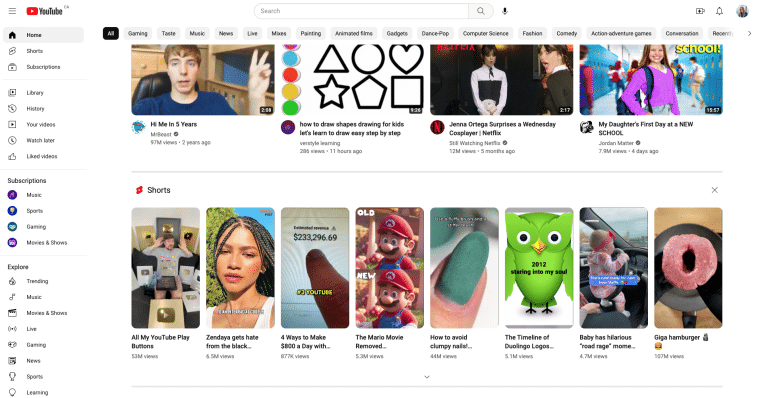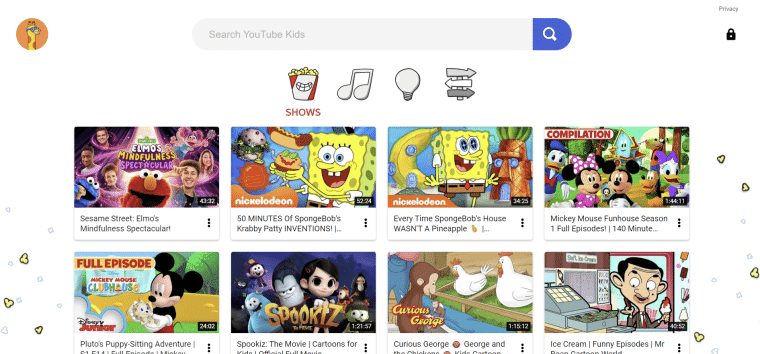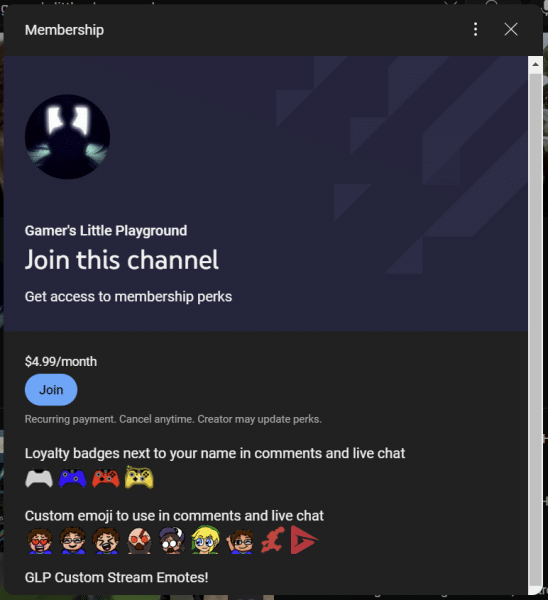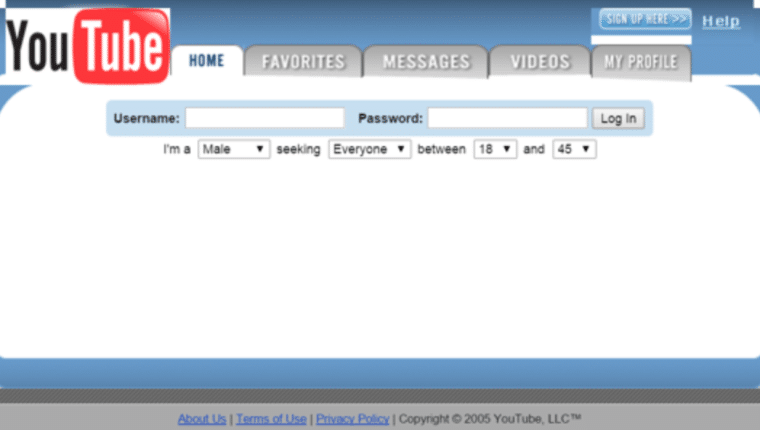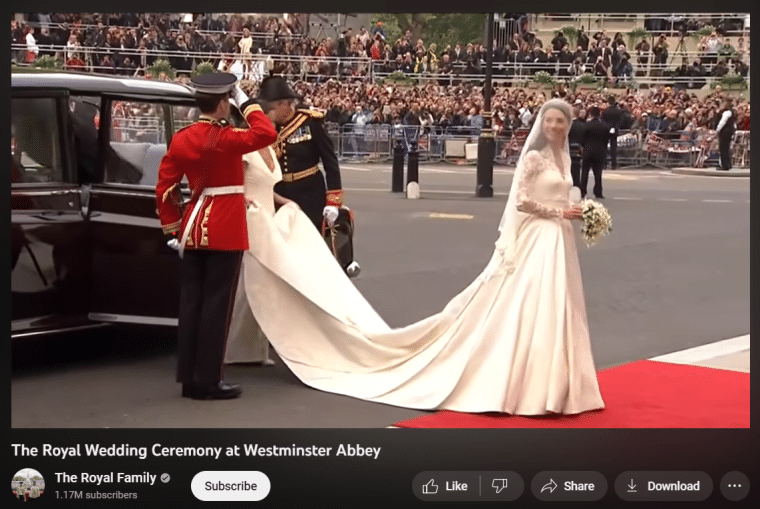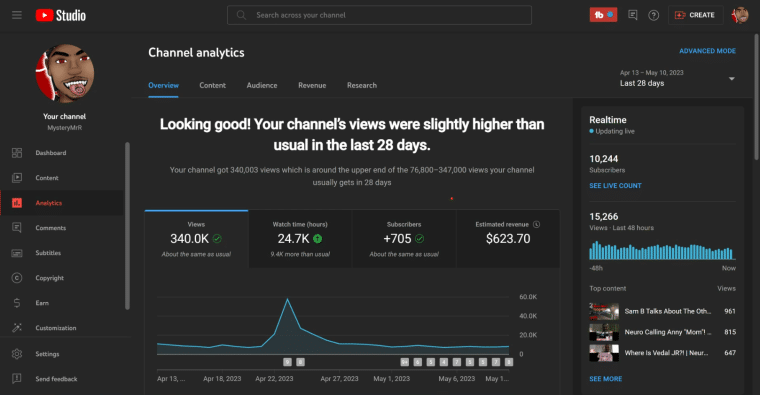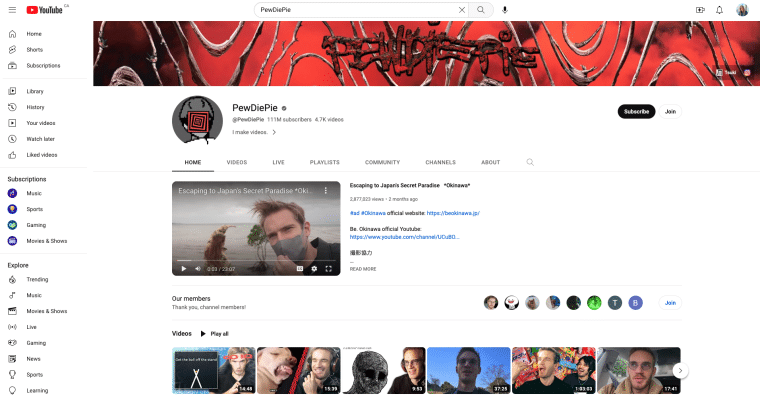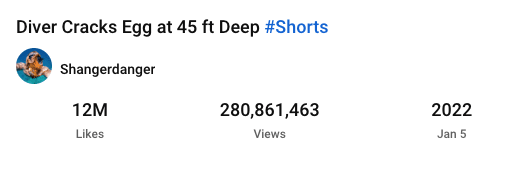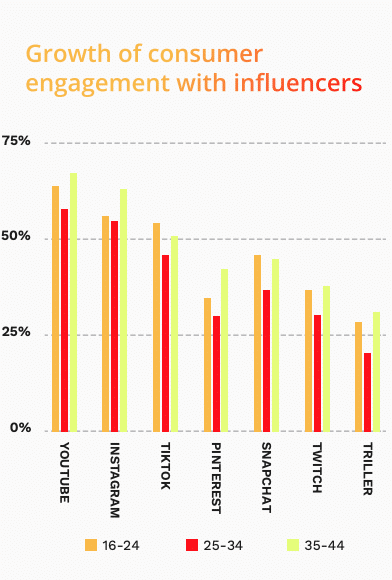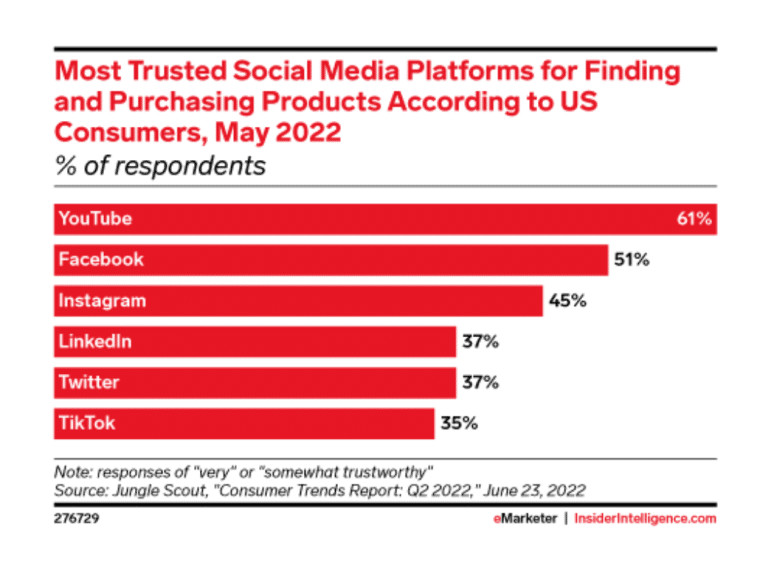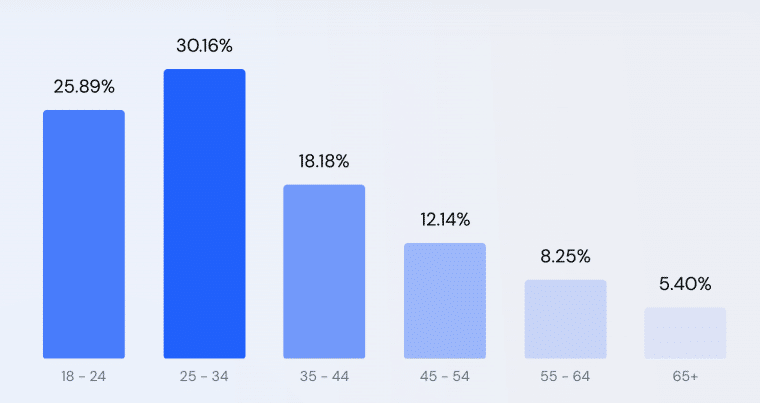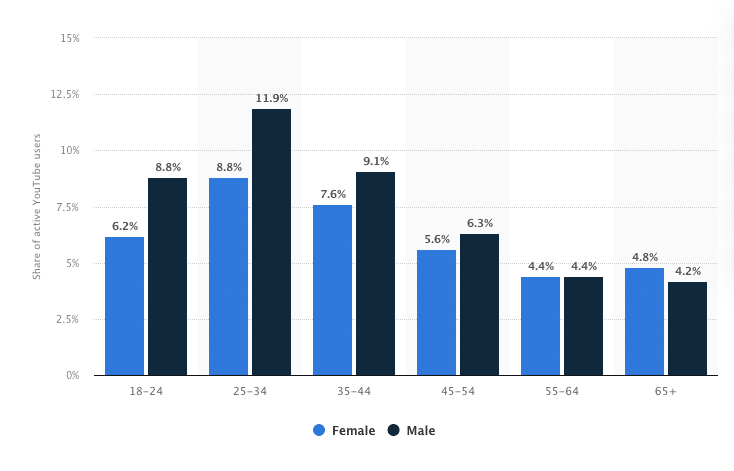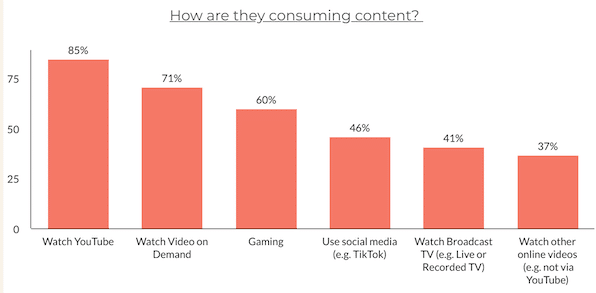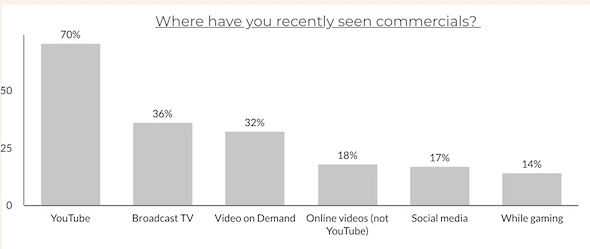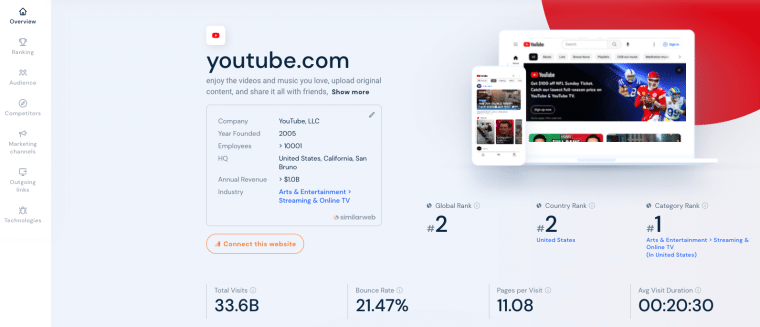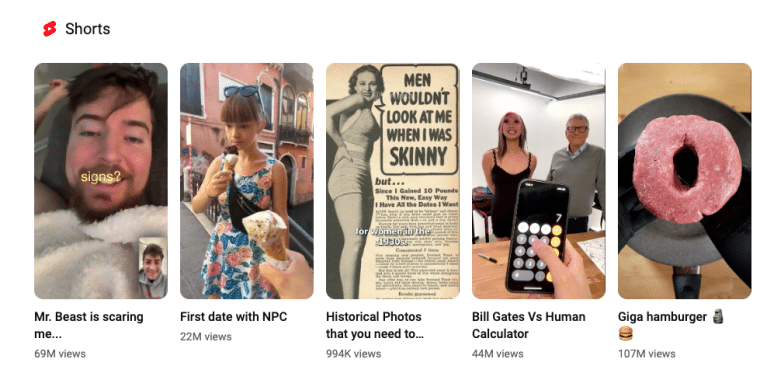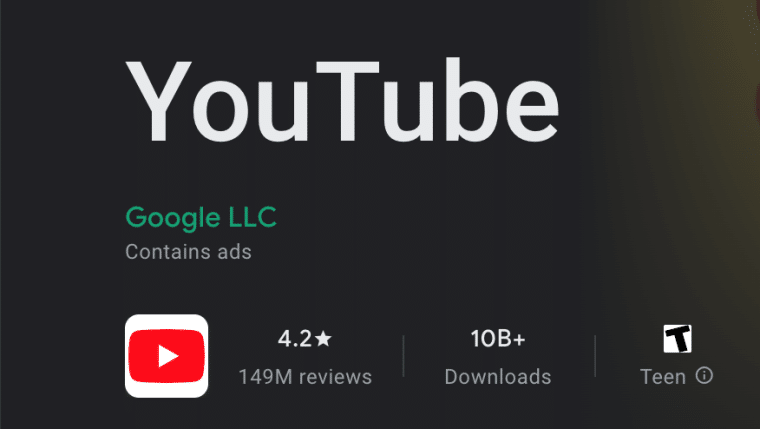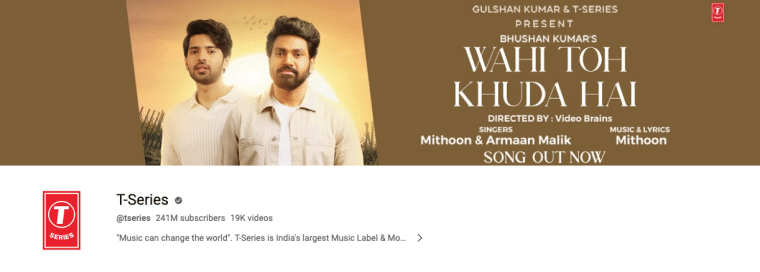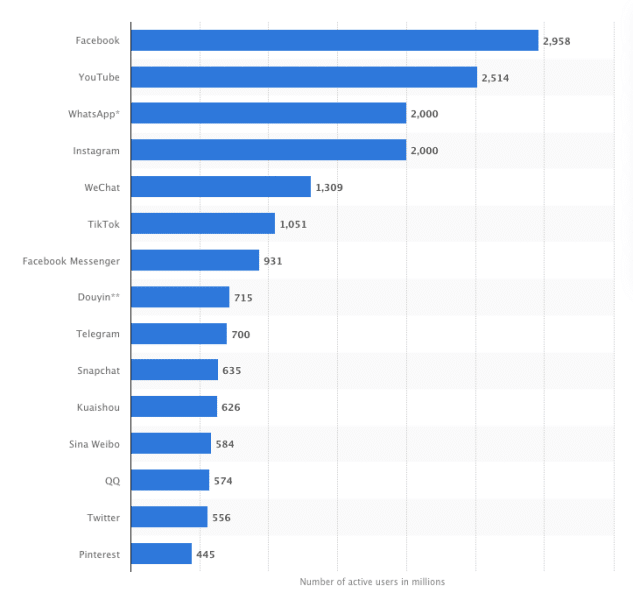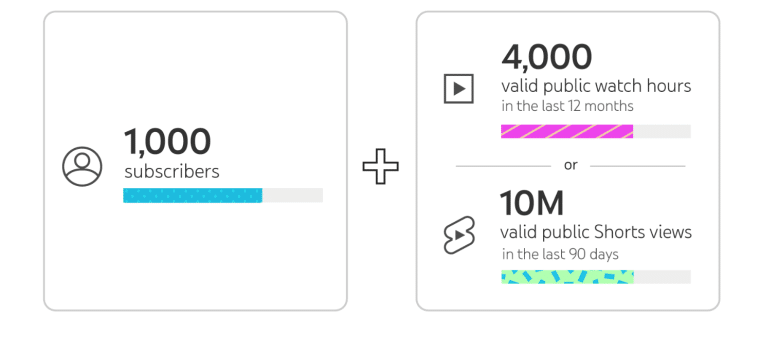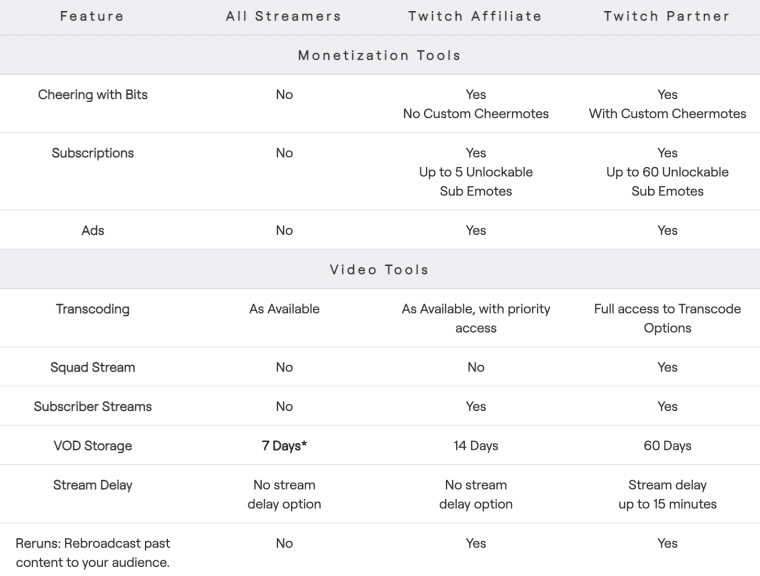YouTube is the almighty host of web video content.
The site is at the forefront of online video streaming because it is a hub for content creators seeking commercial success and individuals sharing their experiences.
Therefore, exploring the key YouTube statistics to gain insight into how this massive platform was established can be fascinating.
With 15 categories to choose from, YouTube provides free and unlimited access to its vast collection of videos, allowing users to create and share their content globally.
On that account, it is no surprise that YouTube ranked # 2 on the list of the most innovative companies in social media in 2023.
This guide will explore various data, including number of Youtube users, and provide an in-depth analysis of YouTube statistics for you to know about the world’s most significant online video-sharing platform.
YouTube is owned by Alphabet, the same parent company as Google – it has never been independently listed on any stock exchange. As of May 2023, Sequoia Capital and Artis Ventures (AV) are among the two investors who have funded YouTube. Since Google acquired YouTube for $1.65 billion in 2006, the platform has been a significant investment for its parent company. It has consistently invested by introducing new features and extending its global influence. YouTube has bought out five companies since 2011: In November 2005, Sequoia Capital invests $3.5 million in YouTube. YouTube secured millions of dollars to enhance its servers and bandwidth, enabling the platform to launch publicly. YouTube secured a further $8 million in funding from Sequoia Capital and Artis Capital Management in April 2006. Seven months later, in November 2006, Google announced its acquisition of YouTube for $1.65 billion in stock. July 2010 saw YouTube launch its Partner Grants Program. $5 million dollars were invested into YouTube’s Partner Grants Program, a content partner program, giving a share of ad revenue to video creators. YouTube announced a $100 million investment in original content in October 2011. One of YouTube’s most significant initial investments set off the creation of over 100 new channels and shows, many of which have become quite popular. Next New Networks Acquisition was bought out by YouTube in March 2011. YouTube acquired the online video production company Next New Networks for approximately $100 million. YouTube Kids hits the market in February 2015. YouTube invested heavily in its YouTube Kids platform, including creating original programming for children and partnering with educational organizations. In June 2015, YouTube launched YouTube Gaming in response to the increasing popularity of game streaming on platforms like Twitch. This service provides viewers with gaming-related content including live streams, gaming news, and other videos. YouTube bought out FameBit in October 2016 to help link creators with brands for sponsorships. This boosted YouTube’s ad revenue and offered creators more chances to monetize their content. To attract musicians with money-making tools, YouTube acquired Bandpage for $8 million in February 2016. In February 2017, YouTube TV launched live television programming. Since then, the service has experienced rapid expansion and is accessible in more than 100 markets across the United States. June 2018 welcomed YouTube Music & YouTube Premium. YouTube’s music streaming service is a free, ad-supported version and a premium subscription service called YouTube Music Premium, allowing users to listen to music offline and ad-free. YouTube made a $20 million investment in educational content on its platform in November 2018. In December 2021, YouTube acquired Simsim, an Indian social commerce start-up, for $100 million. YouTube Shorts creators received $100 million in May 2021. The fund was distributed throughout 2021-2022 to thousands of YouTube creators with the most engagement as an initiative to promote YouTube Shorts. YouTube reported revenue growth of over 30% from 2019 to 2022. 2010 0.8 In 2022, Alphabet generated $282.8 billion in global annual revenue, of which YouTube accounted for 10.3%. Some crucial YouTube statistics in relation to revenue are: YouTube’s primary revenue source comes from advertising. The platform earns money by displaying ads on its site before, during, and after videos. Advertisers target their ads based on demographics, location, and interests. Between 2021 and 2022, YouTube experienced a $398 million increase in ad revenue. This growth was driven by advertisers’ increased spending and improvements to ad formats and delivery. In 2022, YouTube’s global advertising revenue exceeded $29 billion. This represented about 11.35% of Google’s total annual revenue that year. YouTube collects 45% of the ad revenue generated from a watch page. Creators receive a 55% share of the net advertising revenues generated from ads that appear on their public videos on YouTube’s Content Watch Page or are streamed within the YouTube video player on other platforms. Youtube collects 55 % of the ad revenue generated from Shorts feeds ads. Creators receive 45% of the ad revenue based on their share of views from the Creator Pool allocation. YouTube’s advertising platform, Google Ads, works on a bidding system. Advertisers bid on the cost per view (CPV) or cost per click (CPC) for their ads. The average CPV (cost per view) on YouTube ranges from $0.10 to $0.30. If your maximum CPV is $0.12, with a $3,000 budget, you will reach approximately 250,000 views. The average CPC (cost per click) ranges from $0.30 to $0.50. For example, if the CPC is $1.75 and you want to reach 3,500 clicks on your ad, your campaign budget should be around $6,125. However, these costs vary depending on the target audience, ad format, bidding strategy, etc. A portion of YouTube’s non-advertising revenue comes from subscription fees generated from YouTube Premium and YouTube TV. YouTube Premium and Music have a subscriber base of over 80 million worldwide. This is a 50 million increase in paid subscribers since October 2020. Providing an exact figure for YouTube Premium’s annual revenue is difficult as the company doesn’t disclose this information separately. Creators with over 1,000 subscribers can market channel memberships to their audience. Viewers pay a monthly fee to support their favorite creators and access exclusive content and other perks. Pricing for these monthly subscriptions varies based on region and creator level. Memberships can start at $0.99 and go up to $499.99 per month. YouTube deducts a 30% share of channel memberships revenue; the remaining 70% of earnings goes to creators. The exact amount of revenue that YouTube makes from YouTube TV is not publicly disclosed. YouTube TV operates on a subscription model and charges a monthly fee for its services. As of May 2023, the monthly subscription fee for YouTube TV was $64.99. It can be assumed that YouTube generates significant revenue from its TV subscriptions, but the exact amount is unknown. In July 2022, Google announced that YouTube TV surpassed 5 million accounts – making it the biggest internet-based TV service in the US. A 2021 survey report on influencer marketing by Takumi International, revealed that 56% of consumers in the US and UK reported an increase in their engagement with creator content on YouTube since 2020. The revenue generated by influencer channels on YouTube can vary greatly depending on various factors such as the niche, audience, and engagement. According to a 2020 Statista report, the types of channels that have the fastest-growing YouTube categories worldwide include: In 2021, MrBeast (Jimmy Donaldson) was the highest-earning YouTuber globally, with an estimated income of around $54 million. MrBeast’s content falls under the category of entertainment. His videos have gained a massive following, often involving stunts, challenges, and philanthropic endeavors. YouTube is a well-known American online video streaming service that caters to billions of users around the globe. The limited choices for sharing videos online led to the company’s founding. Co-founder Jawed Karim noted that incidents like the 2004 Boxing Day Tsunami and Janet Jackson’s wardrobe malfunction also played a role in this inspiration. YouTube has achieved remarkable growth and success as a leading online video streaming platform. The following timeline highlights its journey to attain global market dominance: 2005 – February – YouTube data trademarked and registered April – First-ever YouTube video upload May – YouTube Beta Launch September – YouTube reaches its first 1 million views with a Nike ad December – Official website launch December – SNL skit “Lazy Sunday” goes viral on YouTube and NBC demands its removal 2006 – Google purchases YouTube 2007 – YouTube Partner Program 2009 – U.S Congress Official YouTube channel launch 2011 – YouTube live streaming begins in April 2012 – First 1 billion views on a video goes to Gangnam Style. 2013 – YouTube reaches 1 billion unique monthly visitors 2014 – Music Key subscription service is added to YouTube 2015 – YouTube Red replaces Music Key in November 2015. 2016 – Google launches YouTube Go in September. 2018 – June – YouTube Red rebrands as YouTube Premium and launches channel memberships. November – Ad Pods Testing begins. September – AI Video Reach Platform launches. 2020 – YouTube enters the short video industry with YouTube Shorts. 2022 – YouTube is the second most popular social network, with 2.6 billion monthly users. As of November 2022, YouTube surpassed 80 million Premium and Music subscribers worldwide, showing an increase of 50 million subscribers compared to October 2020. Approximately 25.5 million of YouTube’s premium subscribers are from the United States. By the end of 2024, this number is predicted to increase by almost eight million users, bringing the total number of paying subscribers to 27.9 million in the U.S. YouTube Studio was launched in March 2018 as a more modern and streamlined user interface than the old Creator Studio, with more features and tools to help creators manage their content and grow their channels. Content creators use YouTube Studio’s channel management tools, including video analytics, channel statistics, and audience insights. Creators focus on the following four YouTube Analytics to increase the likelihood of content appearing at the top of YouTube search results. What can I do on YouTube Studio? With YouTube Shopping, eligible creators can advertise products from their stores or other brands on YouTube. The merch shelf platform allows creators to: Felix Arvid Ulf Kjellberg, also known as PewDiePie on YouTube, earned $6.83 million in 2019 through branded merchandise sales, according to a report published by Purple Moon Promotional Products. The Swedish YouTuber, content creator, and social media personality is one of the most subscribed-to and popular YouTube creators, best known for his commentary and reaction videos on various video games. In September 2020, YouTube Shorts launched in India as a response to the growing popularity of short-form video apps such as TikTok. Shorts was initially available only in India as a beta version, but by 2021 it rolled out to the US and other countries. Shorts can be up to 60 seconds long and must be uploaded as verticle videos using various creative tools and effects. On top of that, users can also add licensed music from a vast library of songs. In June 2022, Shorts became a significant player in the short-form video market, with 1.5 billion monthly logged-in users and over 30 billion daily views worldwide. However, in less than a year, that number has increased significantly. In February 2023, Sundar Pichai – CEO of Google – announced that YouTube Shorts has passed 50 billion daily views. Since its launch, Shorts has grown in popularity, particularly among younger audiences, and has become an essential part of YouTube’s overall strategy. As a result, the platform has continued adding new features and capabilities to Shorts, such as the ability to sample audio from other Shorts and add captions. As of December 2022, creator Shangerdanger’s short video “Diver Cracks Egg at 45 ft Deep” was ranked as the top-performing YouTube Short. As of January 2023, YouTube reported 2.6 billion monthly active users. This is about 31.25% of the estimated 8 billion global population, meaning around than one-third of the world’s population uses YouTube monthly. More than a billion hours of content are watched across the globe on YouTube every day. And over 500+ hours of content are uploaded to YouTube every minute — equivalent to 30,000 hours of video per hour. YouTube has had the highest growth in consumer engagement with influencers, according to Takumi’s 2021 survey. It is also the most trusted social commerce platform in the US. 64% of consumers find YouTube the most trustworthy for discovering and buying products, according to a survey published by Insider Intelligence. Facebook and Instagram came in second and third place with 51% and 45%, respectively. YouTube is accessible in 100+ countries and in over 80 different languages. Creators from diverse backgrounds use YouTube to showcase their skills and connect with new audiences. India has the highest number of YouTube users, with approximately 467 million users. This number accounts for about 18.68% of the platform’s user base. YouTube is currently banned or partially blocked in several countries due to political, social, or cultural reasons: Men make up 60.51% of the audience, while women account for 39.49% as of May 2023, according to Similarweb. As of January 2023, males constituted most of YouTube’s user base, comprising around 54.4 percent of the total audience. Males between 25-34 represented the most prominent age and gender group among YouTube users, making up 12% of the platform’s global audience. Female users make up approximately 46 percent of the platform’s user base. According to Oxford Economics, female content creators think YouTube is a reliable source: A study conducted by Precise TV in September 2021 uncovered a substantial amount of YouTube statistics related to children in the US. In a survey conducted of 2,000 U.S families: The study also examined how ads across different platforms affect purchasing decisions. YouTube significantly impacts children’s viewing habits, and brands must adjust to this evolving environment accordingly. For media and music companies, YouTube is also a critical online platform: YouTube is the second-largest search engine in the world after its parent company Google. When it comes to user engagement, it’s relatively high compared to other social media platforms – you’re watching videos, after all. On average, visitors spend 20 minutes on the website and view 11+ pages. YouTube also ranks as the top website in the arts and entertainment category and is the leading video-sharing platform. YouTube has become a popular platform for watching videos on the go, with most users accessing it on their mobile devices. As of May 2023, The YouTube app has over 10 billion downloads and 149 million reviews on Google’s Play St. There are over 51 million YouTube channels created by individuals and companies worldwide. T-Series is the YouTube channel with the most subscribers globally as of February 2023, with 237 million users subscribed to their channel. On top of their millions of subscribers, T-Series has the highest number of video views among YouTube channel owners, with 217.25 billion lifetime views. Baby Shark Dance, posted by a South Korean educational company, holds the record for the most views on YouTube – totaling 12.3 billion views. The song gained popularity in many countries and went viral on multiple social media platforms. Oxford Economics reported that users turn to YouTube for information and educational content to enhance their lives. The same study also reported various YouTube statistics regarding its economic impact. YouTube’s headquarters is in San Bruno, California. It’s situated in Silicon Valley, 20 km south of San Francisco and about 40 km north of Google’s headquarters in Mountain View. With over 1,100 employees, the San Bruno location spans about 200,000 square feet. It features a pool, basketball court, and a slide connecting the second and third floors. Google operates several large data centers and server farms to handle the massive amount of user-generated content uploaded and viewed on YouTube. There are 24 Google data centers worldwide: Quilicura, Chile YouTube’s largest data center is located in Berkeley County, South Carolina, spanning over 500,000 square feet and hosting thousands of servers. Other major data centers include locations in: In addition to its own data centers, YouTube also uses cloud computing services from companies such as Google Cloud Platform to help manage its infrastructure and handle peak traffic loads. YouTube’s successful sales channels are responsible for billions of clicks, views, subscriptions, and dollars. This is the primary source of revenue for YouTube, where advertisers pay to display their ads on YouTube videos. As of the end of Q1 2023, Alphabet reported $6.693 billion in ad revenue from YouTube alone. Other YouTube sales channels include: As of January 2023, YouTube is the second-largest social media platform by monthly users after Facebook. It is a unique platform in the market as it caters to a wide range of content categories, including music, gaming, vlogs, educational, and more. Regarding content consumption and engagement, YouTube is still the dominant platform with the most significant daily video views and watch time. YouTube is making considerable progress against TikTok, Instagram, and Facebook to dominate the short video market. In February 2023, Google revealed that YouTube Shorts has surpassed 50 billion daily views, up from the 30 billion daily views reported in Q1 2022. Despite the impressive growth performance, the view count on YouTube Shorts still falls behind that of Instagram and Facebook. In October 2022, Meta announced that Reels had amassed 140 billion daily views across both social media platforms. According to a 2023 video marketing statistics report published by Motion Cue: With YouTube’s new Shorts Partner Program incentive to share ad revenue with creators, we can expect an increase in creators producing original content for the platform. YouTube and Twitch are widely recognized as the most popular video game live-streaming platforms. Google attempted to acquire Twitch for $1 billion in May 2014, but a deal couldn’t be reached. As a result, Amazon later bought Twitch for $970 million. As of May 2023, according to TwitchTracker’s statistics: A Stream Scheme report suggests that YouTube provides better opportunities for new creators to expand their audience. YouTube has a broader variety of content and a larger audience, while Twitch mainly focuses on live-streaming video games and esports. YouTube has 20 times the audience size of Twitch while having fewer streamers. Therefore, there is less competition. The algorithm on YouTube suggests content to new viewers, regardless of whether it is a video or live stream. YouTube videos generate views and revenue at all times, while Twitch streams are only available during the live broadcast, which limits their earning potential. Creators on YouTube earn revenue from both uploaded videos and live streams. Streamers can have two types of relationships with Twitch in order to monetize their channels: Affiliate and Partner. It is required to be an Affiliate to earn money on Twitch through subscriptions, advertisements, or Twitch Bits. To apply for the Partner Program on Twitch, Affiliates need to stream at least 25 hours across 12 unique streams with an average of 75 viewers. The primary source of revenue on Twitch comes from live streaming. Basic Twitch payout is about $0.25 – $1.50 per 1,000 views Twitch Partners can also earn revenue through subs, bits, game sales, and direct donations. Each Bit is worth $0.01 to a streamer, meaning that if a viewer spends $1.40 to buy 100 Bits, Twitch takes a cut of $0.40. YouTube Premium and Netflix are both popular streaming services, but they still differ in several ways: Netflix is a more established streaming service with an extensive library of original content. At the same time, YouTube Premium offers a unique mix of original and user-generated content, along with a range of subscription options and exclusive features. YouTube remains the most popular digital platform for sharing, voicing, listening, and building communities through stories. With the growing popularity of short-form video content, YouTube’s recent push into this area with Shorts is likely to attract and retain younger viewers who prefer short-form content. Given the data and YouTube statistics provided in this article, we can predict other potential trends in the near future: YouTube’s improving advertising capabilities will make it a more attractive platform for advertisers, leading to increased revenue. Its large user base, strong brand, and innovative features are expected to keep it a major player in the online video market for years to come.YouTube Key Statistics
YouTube Investment Statistics
YouTube Major Investments & Acquisitions
YouTube Sales Statistics
YouTube Annual Revenue Statistics
Year Revenue ($) billion 2011 1.3 2012 1.7 2013 3.1 2014 4.2 2015 5.5 2016 6.7 2017 8.1 2018 11.1 2019 15.1 2020 19.7 2021 28.8 2022 29.2 YouTube Annual Advertising Revenue Statistics
YouTube Subscriptions
Plan Pricing (USD) Monthly $11.99 Individual Annual $119.99 Family Monthly $22.99 Student Monthly $6.99 YouTube Revenue by Channel Memberships
Revenue by YouTube TV
YouTube Revenue by Highest Earning Channels
Channels Revenue ($ millions) MrBeast 54 Jake Paul 45 Markiplier 38 Rhett and Link 30 Unspeakable 28.5 Nastya 28 Ryan Kaji 27 Dude Perfect 20 Logan Paul 18 Preston Arsement 16 YouTube History & Timeline
On February 14th, 2005, three former PayPal employees, Chad Hurley, Steve Chen, and Jawed Karim, founded YouTube. It initially had humble beginnings as a dating website called “Tune In Hook Up”, but it quickly proved unsuccessful.
YouTube’s first-ever video is uploaded by founder Jawed Karim on April 23, 2005. The 19-second clip, “Me at the Zoo”, features Karim discussing interesting facts about elephants at the San Diego Zoo.
YouTube launches on a limited basis in May and attracts 30,000+ viewers per day.
A Nike ad featuring Brazilian soccer star Ronaldinho receiving his first pair of Golden Boots gains 1 million views on YouTube. It’s the first significant instance of a company utilizing YouTube as a promotional tool.
In December, YouTube officially launches for users to upload, share, and view videos.
NBC asks YouTube to remove a clip of “Saturday Night Live” due to copyright infringement. YouTube complies and launches the Content Verification Program to assist content owners in preventing future violations.
Only 18 months after its launch, Google acquires YouTube for $1.65 billion, increasing its reach and resources.
In May 2007, users can monetize their viral content, allowing ordinary people to earn money from their interests and hobbies.
Official Congressional YouTube channels launch in January, providing American citizens with access to their government and contributing to YouTube’s mainstream appeal.
Content broadcast includes concerts, the Royal Wedding of Prince William and Kate Middleton, news, events, and the Olympics.
In December 2012, Korean pop star artist PSY’s “Gangnam Style” became YouTube’s most-watched video, surpassing 1.3 billion views and breaking the platform’s view counter.
Approximately 50% of internet users visit the video-sharing platform monthly in March 2013.
In November, users are permitted to stream music videos without advertisements via YouTube’s Music Key subscription.
A new app tailored for low-end devices and countries with limited connectivity enables offline viewing by allowing users to save videos.
YouTube rebrands its YouTube Red service as YouTube Premium, a new version of its YouTube Music subscription service. The same month, channel memberships allow fans to pay a monthly fee and become members of creator channels, gaining access to exclusive perks.
Google announces the testing of ad pods – two stacked back-to-back ads, which viewers can skip if uninterested. The goal is to reduce interruptions later and increase ad views.
YouTube releases an AI-driven ad service, Video Reach to enhance ad performance, audience engagement, and reach. Advertisers can optimize ad combinations without managing individual categories, resulting in cost savings.
As a reaction to the success of TikTok and Instagram Reels, YouTube enables users to create vertical videos at a maximum length of 60 seconds.
YouTube ranks the second most popular social network globally, after Facebook. YouTube Product Statistics
YouTube Premium & Music
Premium Subscription Features Details Ad-free YouTube videos Download YouTube videos to watch offline Play YouTube videos in the background YouTube Music YouTube Kids YouTube Studio (Formally Creator Studio)
YouTube Shopping – Merch Shelf
YouTube Statistics for Shorts
YouTube Audience Statistics
YouTube Users by Country
Country Users (millions) India 468 USA 246 Brazil 142 Indonesia 139 Mexico 81.8 Japan 78.4 Pakistan 71.7 Germany 70.9 Vietnam 63 Turkey 57.9 YouTube Statistics of Users by Gender & Age
Age Distribution of YouTube Users
YouTube Users by Gender
Female YouTube Users
Children Users YouTube Statistics
The Media Industry & YouTube
YouTube Website Statistics
YouTube Statistics Mobile vs Desktop Usage
Most Popular YouTube Channels Data
Top Channels Subscribers (millions) T-Series 237 YouTube Movies 163 Cocomelon – Nursery Rhymes 155 SET India 152 MrBeast 136 Music 118 PewDiePie 111 Kids Diana Show 109 Like Nastya 104 Gaming 94.3 Most Watched YouTube Videos
Video Title Views (billions) Baby Shark Dance – Pinkfong 12.3 Despacito – Luis Fonsi ft Daddy Yankee 8.1 Johny Johny Yes Papa – LooLoo Kids 6.59 Bath Song – Cocomelon 5.96 Shape of You – Ed Sheeran 5.89 See You Again – Wiz Khalifa 5.76 Phonics Song With Two Words – ChuChu TV 5.12 Wheels On The Bus – Cocomelon 4.84 Uptown Funk – Mark Ronson ft Bruno Mars 4.82 Learning Colors – Colorful Eggs On A Farm – Miroshka TV 4.8 Societal Impact of YouTube
Economic Impact of YouTube
YouTube Business Data
YouTube Headquarters
Continent Locations North America Berkeley County, South Carolina
Council Bluffs, Iowa
The Dalles, Oregon
Douglas County, Georgia
Henderson, Nevada
Jackson County, Alabama
Lenoir, North Carolina
Loudoun County, Virginia
Mayes County, Oklahoma
Midlothian, Texas
Montgomery County, Tennessee
New Albany, Ohio
Papillion, Nebraska
Storey County, NevadaEurope Dublin, Ireland
Eemshaven, Netherlands
Fredericia, Denmark
Hamina, FinlandAsia Changhua County, Taiwan
Inzai, Japan
SingaporeSouth America YouTube Sales Channels Statistics
YouTube Advertising Revenue
YouTube vs Other Social Apps Statistics
Most Popular Social Networks Worldwide:
YouTube Shorts vs Reels vs TikToks
YouTube Partner Program Eligibility
Twitch vs YouTube Gaming
Platform Partner / Affiliate Program Requirements YouTube Twitch YouTube vs Netflix Streaming Services Data
YouTube Premium Netflix Content Price Features Accessibility Wrapping Up: The Future of YouTube
FAQs
How do I start a YouTube Channel?
Can I make money on YouTube?
What is a YouTube Short?
References
